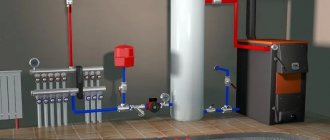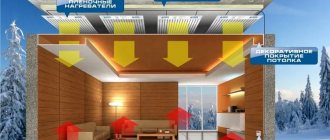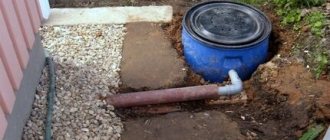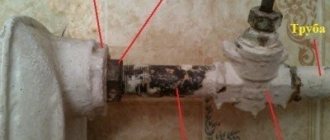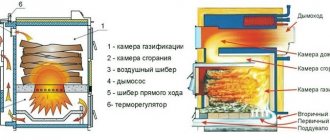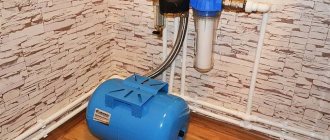Greenhouses with geothermal heating are an original method of using energy from renewable sources and the elementary laws of physics. The scope of application of this alternative type of energy is quite extensive, but most often it is used for heating livestock farms, poultry farms and greenhouses. The use of natural heat sources makes it possible to obtain significant savings and, consequently, reduce the cost of agricultural products. Calculations of a geothermal heating system for each object are made individually.
Geothermal heating and its benefits
The purpose of the greenhouse heating system is to provide temperatures sufficient for growing crops and ripening their fruits. To maintain the required temperature inside the greenhouse, the greenhouse effect alone will not be enough in winter, but the use of traditional heating systems leads to a significant increase in the cost of the production process. Contrary to the popular belief that new methods of alternative energy saving are something akin to a perpetual motion machine, geothermal heating systems actually work to save money and have a number of undeniable advantages:
- working completely autonomously, they do not require energy supplies and are completely independent of changes in their cost,
- operation of geothermal systems is a low-cost procedure,
- systems do not require expensive maintenance, approvals, periodic repairs,
- subject to high-quality implementation, the service life of the geothermal heating system will be at least 50 years,
- the system allows you to ensure the desired temperature inside the greenhouse throughout the year,
- with a balanced soft microclimate in the heated space, the system produces uniform ventilation and regulates the level of humidity.
Peculiarities
It is worth mentioning several features of geothermal home heating systems.
The difference, for example, from a gas or electric boiler is that it does not require heating the coolant to high temperatures. Low-temperature operation ensures lower energy costs. As is known, in a heating system, an increase in the surface of the radiator is used to compensate for the low temperature of the coolant. To avoid this, it is recommended to use warm floors. In this case, this type of home heating will be more rational, since the heat will flow directly into the living area, and not into the space under the ceiling of the room.
In addition, it is worth recording the minimum heat loss as an asset for heated floors. The amount of heat loss mainly depends on the temperature delta. In the case of low temperature geothermal heating, these losses are minimal. The second significant advantage of underfloor heating is that the house structures themselves (in this case the floor) are directly heated. In the case of radiators, the heated air only slightly covers the glazing of the windows and part of the nearby wall.
Geothermal heating - how it works
The functioning of geothermal heating systems is possible due to the stable temperature of the soil at certain depths. In winter, it can be 5-7 degrees C, in summer - 10 - 12. These indicators are quite enough to ensure the basic temperature in greenhouses; due to solar radiation and the presence of the greenhouse effect, in winter the air temperature in the greenhouse increases several times.
In the summer heat, the system works to normalize the microclimate by lowering the temperature to 23-27 degrees. In principle, this temperature is optimal for growing almost all types of vegetable crops. Thanks to air exchange, the soil accumulates heat during the day, and at night it releases it and heats the greenhouse, which helps equalize day and night temperatures.
Geothermal greenhouses turn out to be effective even in northern conditions; of course, in harsh cold climates, additional heating will be required, but the costs for it will be quite acceptable.
Of course, building a greenhouse with geothermal heating is not an easy task; the first problem is the extraction of a huge volume of soil - after all, the installation of underground communications will be required at great depths. However, the cost of building materials will be significantly lower than the estimated costs of gas or electricity used in traditionally equipped greenhouses, and the efficient operation of the geothermal system will quickly compensate for all financial costs.
How to choose a heat pump?
Having calculated the power of the heat pump, all that remains is to choose its characteristics, on which its functionality and price depend. Among the main criteria it is worth paying attention to:
- Power supply format - the system can be powered from a single- or three-phase network, or of a combined type. For models with a power of 3.5 kW/h or more, it is recommended to connect to a three-phase network.
- Compressor type - most systems are equipped with an inverter compressor, which produces low noise levels and is characterized by low energy consumption. Scroll compressors have a longer service life, but cost more; screw compressors have high efficiency, but are very noisy.
- Operating mode - HP can operate in automatic or manual mode. Additionally, the presence of an energy-saving mode and frost protection is appreciated.
- Water heating temperatures - on average, the heating temperature of the heater is 55–80 degrees. A model with water heating up to 55 degrees provides a hot water temperature of 45–48 degrees, which is already enough for domestic needs. In bivalent boilers, the DHW temperature can be increased through the operation of heating elements or a heat generator.
- Noise level produced - Heat engines produce between 39 and 62 dB of noise. Too noisy systems can interfere in the residential sector; the optimal placement is 5–6 m from the nearest building, including from neighbors’ houses.
- Type of refrigerant used - heat pumps usually work with R134A, R407C or R410A freon, less commonly R22 is used. The main difference is the price and environmental impact.
In addition, you need to understand the configuration and additional options. The most popular additional An option is a water heater with a separate circuit, which allows you to organize hot water supply. For regions with cold climates, a heating element can be additionally installed to the heat pump, which increases the thermal capacity of the system in case of severe frosts. Models with remote control stand apart. The operation of modern heat pumps can be controlled via an application via Wi-Fi, or by connecting to a smart home system.
Heating system design
At its core, the design of a geothermal heating system is quite simple. It consists of two contours located under the soil layer and on the surface. With the help of the first, thermal energy is collected, i.e. it is a heat exchanger. Its installation is carried out either in non-freezing reservoirs at an appropriate depth or in the ground, below its freezing point.
The secondary circuit pipes are filled with water or water with the addition of an appropriate amount of antifreeze. The energy collected by the coolant is supplied to a heat pump equipped with two heat exchangers; geothermal heating works precisely from the energy obtained in this way.
There is also an option when a well is drilled to a depth of about 100 m for geothermal heating; this option is much more effective, but drilling to such a depth is very expensive.
Let's sum it up
Don't be intimidated by the impressive scope of work. Experience shows that from the zero cycle to the installation of filters it takes about 3 weeks, which, taking into account the half-century operation of the system, is simply insignificant. Such schemes are widely used in regions with a frosty climate, among the leaders is Greenland, whose vast territory is always hidden under a layer of snow. Remember that once you spend 3 weeks, you will not devote another minute to the system. For correct operation, no external influences are required; it is enough to only occasionally clean clogged mosquito nets.
Planning
First, it should be noted that an existing greenhouse cannot be equipped with effective geothermal convection. This is difficult to accomplish from the technical side, but even in the case of modernization, the efficiency obtained from it will be significantly lower than what can be obtained with the correct implementation of design work for the construction of a new facility.
Secondly, to obtain an economic effect, geothermal systems should be designed in year-round greenhouses, and their minimum area should not be less than 50 square meters. m, increasing the area will improve efficiency. The site for the construction of the facility and its dimensions should be determined before the start of design work.
Determining the location for construction is of no small importance; the dimensions of the site should significantly exceed the area of the future greenhouse. There should not be any buildings or trees growing on the site. When planning a greenhouse with a length and width exceeding 14 m, the dimensions of the sides of the pit should be increased by 3.5 m. If the length of the sides is less than 14 m, you will need a pit, the dimensions of the sides of which will exceed the sides of the structure by about a third.
You can dig a pit with your own hands, but you can use equipment in the process. The following materials should be prepared:
- clean river sand,
- small crushed stone,
- rubble brick,
- polystyrene boards,
- 110 mm pipes and joint connections to them.
It is difficult to name the exact amount of costs; approximately, geothermal heating costs about 120 - 140 dollars per square meter. m of finished heated structure. The density of underground communications will be inversely proportional to the average temperature indicators of a particular climate zone.
Geothermal heating installation
The main characteristic of a functioning heating system is the number of calories of thermal energy that it produces. Since there is no regulatory framework for geothermal heating systems, when carrying out detailed calculations it is recommended to use the provisions of SNiP relating to the design and installation of general-purpose climate systems.
Effective operation of the system can be ensured by air ducts whose placement density will be no less than 2.7 m per 1 sq. m. m, in cold climates underground communications are placed more densely.
INFRARED RADIERS WITH YOUR HANDS
Heat sources - infrared emitters, called eco-heaters - are another option for heating rooms in a private home, office or factory. The operating principle of an infrared emitter is based on the transfer of thermal energy in the form of infrared radiation to objects that, when heated, release directed heat into the air of the room, into the surrounding space in open areas, etc.
The most effective IR emitters, as alternative heating systems, are capable of heating specific objects or parts of premises. Thus, an IR emitter can heat people working outdoors or in a specific part of the room. The use of IR heaters creates savings on heating, allowing you to heat only the useful part of the space. According to the method of installation and fastening, heaters differ in wall, ceiling, floor, and with directed action of infrared radiation.
Where to start installing geothermal heating equipment
The work will take from 2 to 4 weeks to complete. The most labor-intensive stage will be excavation; the best option is to hire special equipment, namely an excavator. Installation of communications is not particularly difficult; you can handle it on your own.
Depending on the climate and the depth of soil freezing, the depth of the pit is calculated; for areas of the middle zone, a depth of 3 - 3.5 m will be sufficient. If the climate is warmer, then the pit can be made shallower. The top fertile layer of soil is carefully removed and preserved, and the clay layers are removed. The shape of the pit can be rectangular or trapezoidal; its walls do not need to be secured.
At a depth greater than 0.7 m, the pit slopes should be insulated with polystyrene foam boards. The bottom of the pit is covered with crushed stone (15 cm), then a layer of sand, about 30 cm thick, is compacted. Next, the internal contour of each of the walls of the future structure is beaten with a cord and its longitudinal axis is determined.
For laying air ducts, PVC plumbing pipes with a diameter of 110 mm are used. The pipes are laid in accordance with the marked route. It is recommended to lay the pipes in a “snake” pattern; with this option, the pipeline is divided into sections 1.5 - 2 m wide. The distance of the pipeline from the walls of the pit should be from 0.3 to 0.5 m. Each of the air ducts should have a tee connection in the center with three bells. At the next stage, the central branch from this connection is brought up, focusing on the longitudinal axis of the greenhouse.
After the construction of the greenhouse, the central branch of the air duct is increased, and the ends of the pipes should be 30-35 cm below the roof level. The side branches of the segments are also brought up, the distance between them and the walls of the greenhouse should be at least 0.2 m. The central and side branches are muffled using plastic plugs or polyethylene membranes. The vertical sections of the system are fixed by backfilling their base. Branches extending to the surface must be strictly vertical.
Having completed installation of the system, the pit is backfilled to the level at which the upper limit of the heat-insulating slabs is located - 70 cm from the ground level. The area of the pit that will be outside the inside of the greenhouse is covered with a layer of polystyrene foam and covered with a layer of soil until it rises to the soil level.
The walls of the resulting pit are secured using panel formwork, then insulated with polystyrene foam boards. The depression formed inside the greenhouse is filled with chernozem, not reaching the ground level by about 35-40 cm.
principle of organizing the air exchange process
The normal functioning of the system, in principle, does not require the organization of forced air exchange. To avoid sudden temperature changes and improve operating parameters, it is possible to install a homemade exhaust fan and filter device. If a forced air exchange system is installed, it will also filter the air. You can make the system yourself using a fairly simple diagram.
installation of mosquito net
To protect the system from various insects, a mosquito net is installed, the mesh size can be from 02 to 0.4 mm, the net is pulled onto a hoop and glued into the case in which the fan is placed.
how to deal with condensation
Since the temperature indicators of the soil and air can differ significantly, it can be assumed that condensation will form in the pipeline. To prevent this phenomenon, holes with a diameter of 5 mm are drilled in the pipes, up to 15 pieces per linear meter. When laying pipes, the holes should be positioned downwards. To adjust air humidity, water in an amount of 3-5 liters can be added to the segments.
If heating is carried out according to the principle of air convection, then caring for it will only consist of cleaning the mosquito nets. Greenhouses heated in this way are a profitable option for obtaining optimal temperature indicators through the use of autonomous climate control equipment.
Installation and Installation Costs: How Much Does Earth Energy Cost?
Once geothermal heating is started, about 70–80% of the heat comes from renewable energy sources, the rest requires electricity costs. However, at the project development stage, it is necessary to correctly calculate the cost of equipment and its installation.
Heat pump cost
Purchasing a heat pump is usually the largest expense in your budget. The Russian market offers products from 4 brands:
- Henk is a domestic company that produces more than 80 models of heat pumps. The price of the pump is 250,000 rubles and above.
- AlterTeplo - made from imported components. The cost starts from 150,000 rubles.
- NIBE is a Swedish manufacturer. The average cost of a geothermal heat pump from NIBE is 500,000 rubles.
- Waterkotte is a manufacturer from Germany that sells complete systems with a DHW unit. The cost of such a kit starts from 700,000 rubles.
When choosing a manufacturer, be guided by the warranty period, as well as the ratio of power and cost. The cost of a heat pump directly affects the payback time of geothermal heating - be sure to calculate the cost-effectiveness of installing each model according to the project plan.
Components and peripherals
In addition to the heat pump, the purchase of pipes and lines, as well as working fluid, is required. Among the main costs for related components, it is necessary to highlight:
- Pipes - for the external circuit, polypropylene pipes with a diameter of 42 or 40 mm are usually used. The average price of 1 meter of pipe is 35 rubles; in total, the pipe will require around 10–25,000 rubles.
- Heated floors - pipes made of cross-linked polyethylene for heated floors with a diameter of 16 mm cost from 45 rubles per meter. On average, the entire area of the house will require from 4,500 to 15,000 rubles.
- Antifreeze or antifreeze, as well as freon - a liter of working fluid costs 100–200 rubles per liter, the volume of liquid is calculated based on the proportion of 10–20 liters per 1 kW of heat pump power. The price of freon is from 250 rubles per liter.
Additionally, you will also need to purchase fittings and sealing elements, heat insulators, taps, lay wiring, etc. On average, you need to budget 30–50,000 rubles for the periphery.
Installation and connection
The largest part of the installation work is occupied by the development and drilling of the soil, especially with the horizontal method of installing the working circuit. On average, the cost of connecting geothermal heating to a turnkey private house with an area of 100 m2 is 400–500,000 rubles. You can save money if you carry out the excavation work yourself, or order a turnkey installation service from specialists. After launching the system, the owner only has to pay the bill for the electricity consumed, as well as include in expenses the amount for depreciation of the working equipment. Separately, it is also important to take care of the system in the event of a power outage - for example, purchase a generator with automatic start. When choosing a device, you need to calculate the power - the generator must withstand the sum of the starting currents of the compressor and circulation pumps. After restarting the system, about 35–45% of the generator's power will be freed, which will be enough to power other household consumers.

